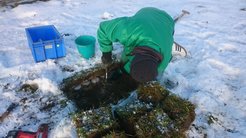Minerals and land use determine carbon storage in soils
Carbon sequestration in soils can contribute to mitigate climate change, and soil organic matter associated with minerals has the highest capacity to store carbon. A team of researchers, including scientists from the Max Planck Institute for Biogeochemistry and the Martin Luther University Halle-Wittenberg, assessed the factors controlling mineral-associated organic matter. Their study, published in Global Change Biology, demonstrates that while the amount and rate of its formation is primarily controlled by the mineral composition, both land use and management intensity also affect mineral-associated organic matter on short time scales.
Soil organic carbon is not only important for soil fertility and food production, but also plays an important role in Earth´s climate since about 7 percent of atmospheric CO2 is cycling through soils every year. Since the onset of agriculture, soils have lost significant amounts of carbon to the atmosphere. To mitigate climate change, we therefore need to understand, how additional carbon losses can be prevented and soil carbon stocks can be restored. When associated with minerals, soil organic carbon has an increased residence time and resistance to disturbances. The formation of mineral-associated organic matter (MAOM) is thus a key process in the global carbon cycle. However, despite decades of research, it remained unresolved how mineral composition and land management intensity affect MAOM formation.

To address this research gap, more than 3500 permeable containers filled with carbon-free goethite, a representative iron oxide in the soil, or illite, a representative silicate clay mineral, were buried at 150 forest and 150 grassland sites. The sites are located in the three German study regions of the infrastructure priority program ‘Biodiversity Exploratories’ funded by the German research foundation (DFG). After five years of incubation underground, a team of scientists led by De Shorn Bramble of the Max Planck Institute for Biogeochemistry (MPI-BGC) in Jena and Susanne Ulrich of Martin Luther University Halle-Wittenberg (MLU), analyzed the container contents. They found that irrespective of land use type and management intensity, goethite accumulated four times more organic carbon than illite. This result underscores that mineral composition is key in controlling the rate and amount of MAOM formation in soils.
“Much of our knowledge about the role of oxides and silicate clays for soil carbon storage has been derived from laboratory studies. Since these two mineral groups interact in natural soils, straightforward differentiation of their individual roles in MAOM formation is not possible”, explains Susanne Ulrich, PhD candidate at MLU. She continues, “Our experimental set-up allowed us to directly compare the carbon storage potential of these two mineral groups under field conditions for the first time. Our results show that not mineral surface area, but surface properties determine MAOM formation, with oxides having a much larger potential to store carbon than silicate clay minerals.”
Due to the long residence time of carbon on minerals, MAOM formation was thought to be relatively insensitive to land use and management on time scales less than decades. However, in their study, the researchers observed that MAOM formation in forests was reduced by harvest intensity and modified by tree species selection. In grasslands, plant productivity as well as plant diversity increased MAOM formation. Both, plant productivity and plant diversity were influenced by fertilization, with fertilization increasing plant productivity but reducing plant diversity.
De Shorn Bramble, PhD candidate at MPI-BGC, illustrates the contrasting new results: “We observed significant land use and management effects on MAOM formation after exposing carbon-free minerals for only five years to ambient soil conditions. These changes are also likely taking place in natural soils but might be difficult to detect with conventional measurement approaches. Our findings and experimental approach might thus be important in predicting how MAOM responds to human activities”. He ends by saying that while mineral composition determines the potential for soil carbon storage, land use influences how much of this potential is realized. Therefore, it is important to continue learning how plant productivity, quality of organic input and the decomposer community interact in MAOM formation of soils under different management.












